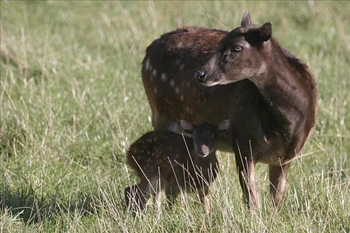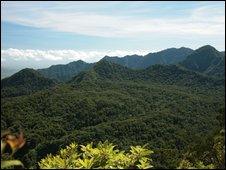Visayan Spotted Deer Droppings Spotted
Posted by: Loren Coleman on May 26th, 2009
For a group of British and Filipino environmentalists, there’s nothing more beautiful than the sight of droppings of the world’s rarest deer.
It’s proof that the Visayan spotted deer (Cervus alfredi), endemic to the Philippines but in danger of extinction, still roam in the wild.
A statement from the British Embassy said the Negros Interior Biodiversity Expedition (Nibe) “has found evidence of two groups of the Visayan Spotted Deer alive and well” in the North Negros Natural Park (NNNP).
Fresh deer droppings, deer tracks and “significant evidence of feeding activity” were documented by the Nibe in its three-week scientific exploration last April in the park.
The NNNP is considered a biodiversity hotspot which means the area has a high level of endemic species.
“The team members did not actually [see] any of the rare Visayan spotted deer, but they found footprints and droppings which prove that a small population survives in the wild, despite the ongoing threat to its survival from hunting and deforestation,” Robert Harland, a trustee of the Bacolod City-based Negros Forests and Ecological Foundation Inc. (NFEFI), told the Inquirer in an e-mail Saturday.
Most endangered

A captive Visayan spotted deer.
The indiscriminate hunting of this timid, exotic and very small animal—it is only around 125 to 130 centimeters long and 70-80 centimeters tall—has made it, in Harland’s words, the “most endangered deer species in the world.”
“It’s believed there are only around 300 deer left in the wild. Sightings of the deer are rare,” he said.
As such, Harland stressed the need for people to be educated and constantly reminded to protect and preserve this rare animal said to have once lived on seven islands but now survives only on Panay and Negros.
“There’s very little that we could do to protect [them except] to educate the people of what a valuable asset the deer are to the biodiversity,” said Harland, a 62-year-old former journalist and media practitioner who has been living in Bacolod since 2001.
Grass-roots conservation
The NFEFI breeds rare and endangered species in captivity including the Visayan spotted deer at the Biodiversity Conservation Center in Bacolod City.
The animals are later released into the wild, according to Harland.
The discovery that “such an important animal [is] alive and well in its natural habitat” proves the effectiveness of grass-roots conservation initiatives in Negros Island, expedition leader James Sawyer said in the embassy statement.
More protection
However, Sawyer still stressed the need for “more protection” of the deer and similar endangered species in the park “in order to assure their survival.”
Dr. Craig Turner, research leader for the expedition, also said in the statement that “Philippine forests still harbor many rare and unique species, found nowhere else in the world.”
He lamented that “conservation work is critically under-funded” and their partners like NFEFI “are fighting a pitched battle to assure [that] future generations are handed their biological inheritance.”
Harland said the expedition was privately funded by the expedition team.
Enviable biodiversity
According to the British Embassy, the expedition team is set to present their findings to the renowned Royal Geographical Society.
“The Philippines’ biodiversity is truly enviable and British visitors come [here] to see endemic species. This is an exciting discovery,” British Ambassador Peter Beckingham said in the statement. He was referring to the discovery of evidence that the rare Visayan spotted deer still roamed the forested park.
Beckingham commended the Nibe for its work for the last 20 years “to save the rainforest through education, reforestation, alternative livelihoods and captive breeding programs.”
Source: “World’s rarest deer still roam Negros,” by Nikko Dizon, Philippine Daily Inquirer, May 24, 2009.

About Loren Coleman
Loren Coleman is one of the world’s leading cryptozoologists, some say “the” leading living cryptozoologist. Certainly, he is acknowledged as the current living American researcher and writer who has most popularized cryptozoology in the late 20th and early 21st centuries.
Starting his fieldwork and investigations in 1960, after traveling and trekking extensively in pursuit of cryptozoological mysteries, Coleman began writing to share his experiences in 1969. An honorary member of Ivan T. Sanderson’s Society for the Investigation of the Unexplained in the 1970s, Coleman has been bestowed with similar honorary memberships of the North Idaho College Cryptozoology Club in 1983, and in subsequent years, that of the British Columbia Scientific Cryptozoology Club, CryptoSafari International, and other international organizations. He was also a Life Member and Benefactor of the International Society of Cryptozoology (now-defunct).
Loren Coleman’s daily blog, as a member of the Cryptomundo Team, served as an ongoing avenue of communication for the ever-growing body of cryptozoo news from 2005 through 2013. He returned as an infrequent contributor beginning Halloween week of 2015.
Coleman is the founder in 2003, and current director of the International Cryptozoology Museum in Portland, Maine.













